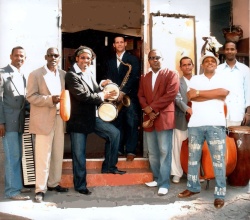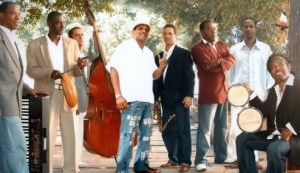Harping in Havana – a bluesman’s introduction to Latin diatonic
 Latin American diatonic for the uninitiated
Latin American diatonic for the uninitiated
To witness Cuba’s musical pulse first hand and sip Mojitos in the sweat of Havana’s Bar Montserrate is privilege enough, but to sit in with the house band Sabor de Cuba, play the diatonic harmonica and get out alive? Ay Caramba! That’s the stuff of dreams.
The Montserrate is a tourist magnet for genuinely good reason. Kitsch-free, under a blanket of humidity and aromatic cigar smoke, the throb of its acoustic Latin music is quite simply mesmerising. Add a splash of Ron Cubano, a serpentine twist of Salsa dancing and you have all the ingredients of an impromptu Latin fiesta. Next time you’re in town, drop in and join the party.
During a break in the music, house vocalist Luis Franklin presented the band’s bongo drums to guests sitting at the bar. Stepping up, the Good Doctor patted a rhythm across the skins which drew a nod of approval from Luis. Followed by an offer of sale. Sadly a shortfall in funds and luggage space forestalled business and in broken Spanish the Doc explained he too was a poor musician. What do you play? Luis asked. The Doc produced a lone Lee Oskar diatonic from his bag.
Luis insisted on hearing the harp, however the ensuing blues riffs failed to impress. While Latin grooves feature strongly in rhythm and blues, evidently the reverse is not true in Cuba. With a rapid volte-face the Doc broke into Cherry Pink (Apple Blossom White).
A grin blossomed on Luis’ face. He pointed to a picture of Perez Prado hanging on the wall and invited his British hermano to sit in with the band during the next set. Luis walked back to the stand. Holding up his harp, the Doc called after him, ‘Key of C….Charlie….uh Carlos!‘ He carved a C in the air. Luis gave a thumbs up.
So can the diatonic harmonica cut it in Cuba?
Si claro! But beware. While they are natural and instinctive players, Cuban musicians are wonderfully disciplined. With all due respect, this ain’t no blues jam. So if you are prepared to join in (preferably by invitation), it is advisable to have a Latin standard up your sleeve. Or else the confidence to play over Latin rhythms and song structures.
At the appointed moment, the Doc joined the band, directed his harp towards the ceiling and took the lead on Cherry Pink (Apple Blossom White). Three minutes later, the room erupted with applause. The Doc pinched himself and privately gave thanks for a Kodak moment – Cuban style.
There is a slight danger that, in the wrong hands, the ‘blues’ harp could be regarded as an American intruder. At the time of writing, the embargo (el bloqueo) that has existed between the two nations since October 1960 is still in place.
Fortunately however, Cubans wear their hearts on their sleeves. If you are willing to speak their musical language rather than impose your own, you will almost certainly be made to feel welcome. Good music is the currency that eclipses politics.
Una más vez!
Later in the set Luis invited the Doc to rejoin the band. Momentarily thrown, the Doc discreetly blew a whisper through his C major harp from the bar. The song was in D minor. He drew hole four and ghosted a few third position licks. Venga!
Conclusion. Third position (Dorian Mode) works fabulously with Latin music. It frees up some really juicy jazz notes, and in the acoustic environment of the Bar Montserrate, against string bass, piano, congas, bongos, trumpet and percussion, the humble diatonic harp seemed to play itself.
After hours
The Doc and his friends returned to the Montserrate for a repeat performance the following evening and as the bar closed, Luis invited everyone to join him for some after hours music and rum a short walk away at the Oasis Club. The Oasis charges a modest entrance fee, but it is worth it. Here the house band uses microphones and a PA, and the bongos and congas are substituted by the timbale.
The music was pumping. The Doc was invited up again, this time sharing the lead spot with a Latin Jazz flautist. Somehow the diatonic harp held its own and, while it may not enjoy any precedent in traditional Cuban music, its novelty factor and some reasonable musicianship ensured it was accepted.
Some starter Latin licks
 Of course Fifth position (Phrygian Mode) would work too, if you are fluent in its application. Using blow 2 or 5 as your root note, on a C harp for example this gives you E minor. Fifth is often referred to as Spanish tuning. Alternatively you can purchase Spanish tuned harps. But more of this in our future posts.
Of course Fifth position (Phrygian Mode) would work too, if you are fluent in its application. Using blow 2 or 5 as your root note, on a C harp for example this gives you E minor. Fifth is often referred to as Spanish tuning. Alternatively you can purchase Spanish tuned harps. But more of this in our future posts.
Meantime here are some simple Latin licks to try out. Remember you have to get with the groove. Percussion and rhythm are the heartbeat of the Latin musical treasure trove. Oh, and by the way, Luis is now the proud owner of a C major Lee Oskar harmonica. It would have been rude to leave without saying thank you. We’re on a C major diatonic..
Lick 1
2D 3D..2D
4B..5B..4B
4D 5D
4D..4B
5B (..4B)
Lick 2
2D
2D”
2D..1D
1D..2D”..2D
NB: Avoid 2B. Breath around it. It’s not a Latin note.
Lick 3
2D 2D 2D” 1D
2D 2D 2D
2D”..1D
(2D”..1D)
Lick 4
4D 6B
4D 4D’ 3D’ 4D’
4D 6B 4D 4D’
Lick 5
4D 6B
4D..4D’ 6B
4D’..4B 6B
4B 3D
3D 4B 4D’
Repeat


This is pretty damned cool, Wilf.
Cheers Elwood. I intend looking into this rich topic a little more in future posts. There is a lot of fun to be had. For bluesers there are some ‘must play’ pieces which include Cherry Pink by the Thunderbirds, La Cucaracha by Big Walter, Cha Cha Cha in Blues by Junior Wells and perhaps Charlie Musselwhite’s Cha Cha The Blues and Christo Redemptor.
To move fully into Latin diatonic, in my humble opinion there’s none better than Rory McLeod. The South American influences on his Footsteps And Heartsbeats album are stunning. Treat yourself; pour a Tequila and listen to The Mariachi’s Love Song.
I am looking forward to feedback from the community on other players who use this area of music for their harp playing.
Whilst you check out all the above, marvel at Rory in action http://www.youtube.com/watch?v=oxcS74-zVIg
It would also be really helpful to get a sense of the characteristics of Cuban music in general. Harp players have a tendency to just learn the characteristics of harp players in general.
For example, what’s happening rhythmically? Are there signature chord progressions? Now, you’ve done us a service but sharing lessons learned from your own baptism by fire, but anyone hoping to gate crash a Bueno Vista Social Club should seek those answers first.
p.s. You said in Lick 2 to avoid the two-hole blow, which is the major 6th if I ain’t mistaken. But in one of the other Licks we see the five-hole blow coming into play, which is the same note. Does it differ from song to song?
One man with a whole lot of Latin in his harp is Joe Powers, tango harmonica specialist. He does wonderful stuff on chromatic and diatonic both: http://www.joepowers.com/
More great questions Elwood. I intend covering these topics in subsequent posts, but since you’ve clearly been inspired, here’s a synopsis..
First the subject of rhythm. The bedrock of Cuban and Latin music is a beat called Clave. Pronounced ‘Clah-bay’. Typically this is tapped out using two short hardwood percussion sticks with the same name (http://en.wikipedia.org/wiki/Claves). The clave rhythm comprises three long beats followed by two short beats, or the reverse. A prime example of the 3-2 clave beat is almost everything by Bo Diddley http://www.youtube.com/watch?v=sgBbmuD_LQw Billy Boy Arnold often helped out on the harmonica. You may prefer the song Hand Jive http://www.youtube.com/watch?v=Xrdjxj3lMD0 (or its derivitive used in the movie Grease).
The reverse 2-3 clave is best illustrated by a Cuban song called The Peanut Vendor. Here’s a version by mambo king, the great Perez Prado (mentioned in the post above) http://www.youtube.com/results?search_query=peanut+vendor+perez+prado&aq=3 This beat is a little trickier to get into, but once you’re there, it’s naturally infectious. Count ‘one’ dah-dah, and dah, dah, dah. More on the roots of this world famous tune here http://en.wikipedia.org/wiki/The_Peanut_Vendor
Here’ a fabulous lesson in clave on the Conga drums. http://www.youtube.com/watch?v=C9OE9tOTBjY&feature=related The comment about incorporating the beat is so central to the whole subject. This is dance music. You cannot sit still once it starts cooking. So live it. Breath it.
And on to chord progressions in Latin music. This is a MASSIVE subject. Depending on the Latin style – clave, mambo, cha-cha-cha, tango, rumba, samba, salsa and everything in between (each has its musical nuances), not to mention all the wonderful Afro-Caribbean and American beats, the chord progression will vary. Cuban Guajira or country music has a very special chordal twist to it.
In Rhythm and Blues there is a strong tradition of switching between Latin rumba and a straight shuffle beat using the typical blues I, IV, V progression. But if we were to focus on the Latin side of things, we’re looking at a sway between two keys a semitone apart, or a movement up and down in semitone steps. Here Todd Parrott demonstrates a Spanish tuned Marine Band harmonica which switches between the chords of E and F http://www.youtube.com/watch?v=higvIZUKlJg. The audible effect is self evident. Reggae follows the same principle.
Of course a great exponent of the Blues-Latin crossover is Carlos Santana. No finer example than his hit cover of Peter Green and Fleetwood Mac’s Black Magic Woman http://www.youtube.com/watch?v=eaKnRUfh_5I&feature=fvw
Another entry point into Latin music is through piano. Personally I get off on this aspect of Cuban music. It’s just too sexy for words. Check this excellent footage out http://www.youtube.com/watch?v=1omyxeeudaE Watch how the hands move up and down in semitone steps.
On the subject of Perez Prado by the way, many will have been recently introduced to his music by way of the Mambo No.5 hit single http://www.youtube.com/watch?v=uz4eHPD40w4 and maybe the Guiness advert which preceded it by a few years http://www.youtube.com/watch?v=jdKI1TyDhaw
I’ll get back to you on the 2B topic next. It’s to do with modes and positional playing.
Cheers!
just came across this cuban piece (and your brilliant site). thanks a lot.
Muchas Gracias Blue Harper. Hopefully we’ll add some more, timer permitting.
Your info is fabulous. Now, maybe you can tell me why Charlie Musslewhite told me to look up Miguel in Havana. Who is Miguel?
Thank you!
Carol it’s all here on our website Havane BLues Society.. https://www.harpsurgery.com/havana-blues-society/
If you’re going to Havana and want to contact Miguel, let me know and I’ll put you in touch.
Doc x